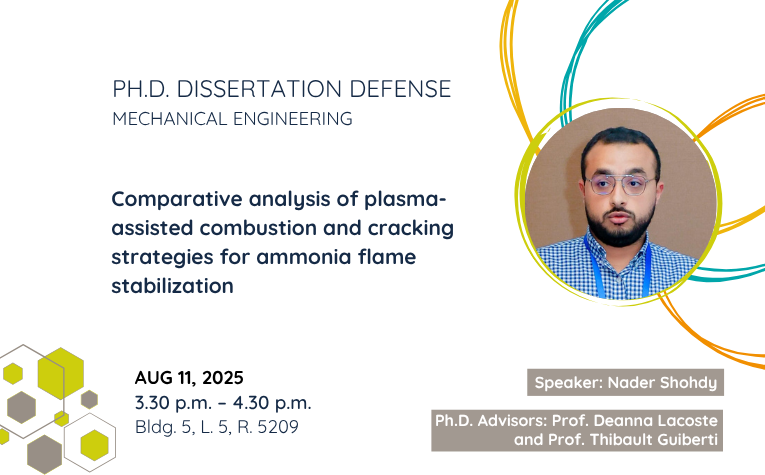Aug 2025
Comparative analysis of plasma-assisted combustion and cracking strategies for ammonia flame stabilization

Zoom link: 🔗 https://kaust.zoom.us/j/92129975139
Abstract
Ammonia (NH₃) is a promising carbon-free fuel due to its high energy density, established transport infrastructure, and potential for green production from renewable hydrogen. However, its practical deployment in combustion systems is hindered by low burning velocity, narrow flammability limits, and high NOₓ emissions. This study presents a systematic comparison of two performance-enhancing strategies—partial thermal cracking and plasma-assisted combustion (PAC)—applied to swirl-stabilized premixed ammonia flames. Thermal cracking (10–28% NH₃ dissociation to H₂/N₂) increases flame reactivity and extends the lean blow-off (LBO) limit, but also elevates NOₓ emissions due to higher flame temperatures and enhanced radical pathways. Chemiluminescence imaging reveals increasingly compact and brighter flames with more H₂ content, while flame transfer function (FTF) measurements indicate stronger thermoacoustic coupling and multiple gain peaks at ≥20% cracking. Nanosecond-pulsed PAC, applied at powers up to 99 W, extends the LBO limit by up to 10%, though less effectively than thermal cracking at equivalent energy input. PAC induces a voltage-dependent shift in radical populations, increasing NOₓ at moderately lean conditions (ϕ = 0.8) but reducing NOₓ near stoichiometry. Under very lean conditions, PAC suppresses NH₃ slip and N₂O formation without a significant NOₓ penalty. When combined, 10% cracking with PAC achieves synergistic LBO enhancement, but further cracking reduces PAC effect due to flame extinction strain-rate sensitivity. PAC also attenuate or amplify the FTF gain by influencing the energy loss fraction and reduced electric field, offering a potential means for controlling thermoacoustic instabilities. These findings demonstrate the complementary benefits and limitations of thermal cracking and PAC, providing valuable insights into the design of stable, low-emission ammonia combustion systems for future energy applications.
Biography
Nader Shohdy is a Ph.D. candidate in Mechanical Engineering program in PSE division at KAUST's Clean Energy Research Platform , where he conducts experimental research under the supervision of Prof. Deanna Lacoste and Prof. Thibault Guiberti. His research focuses on plasma-assisted ammonia combustion, particularly in blow-off, emissions, and plasma-flame actuation strategies. Nader holds a master’s degree in Thermal Power Engineering from Beihang University in China.He earned his bachelor’s degree in Mechanical Power Engineering from Tanta University in Egypt.